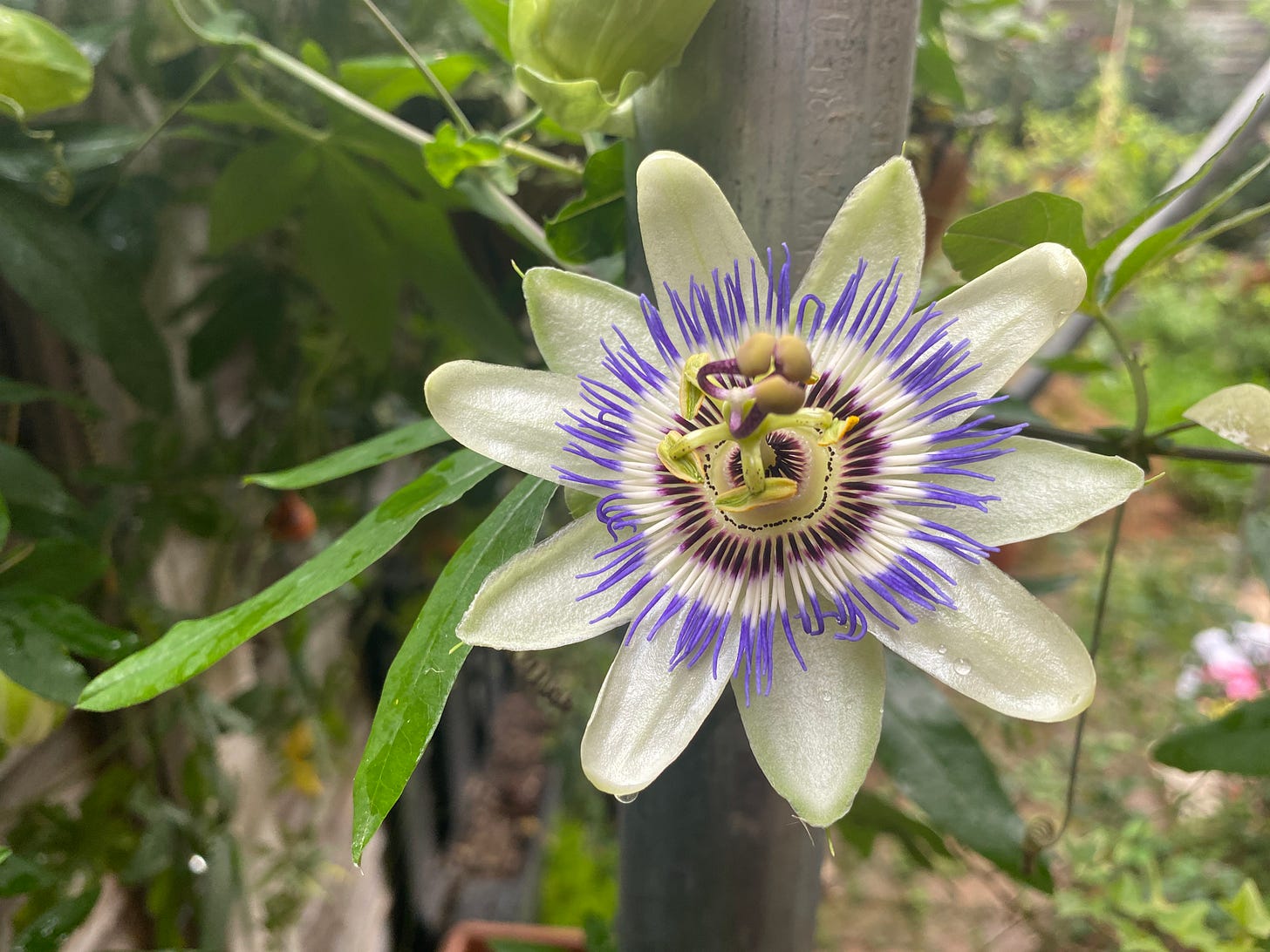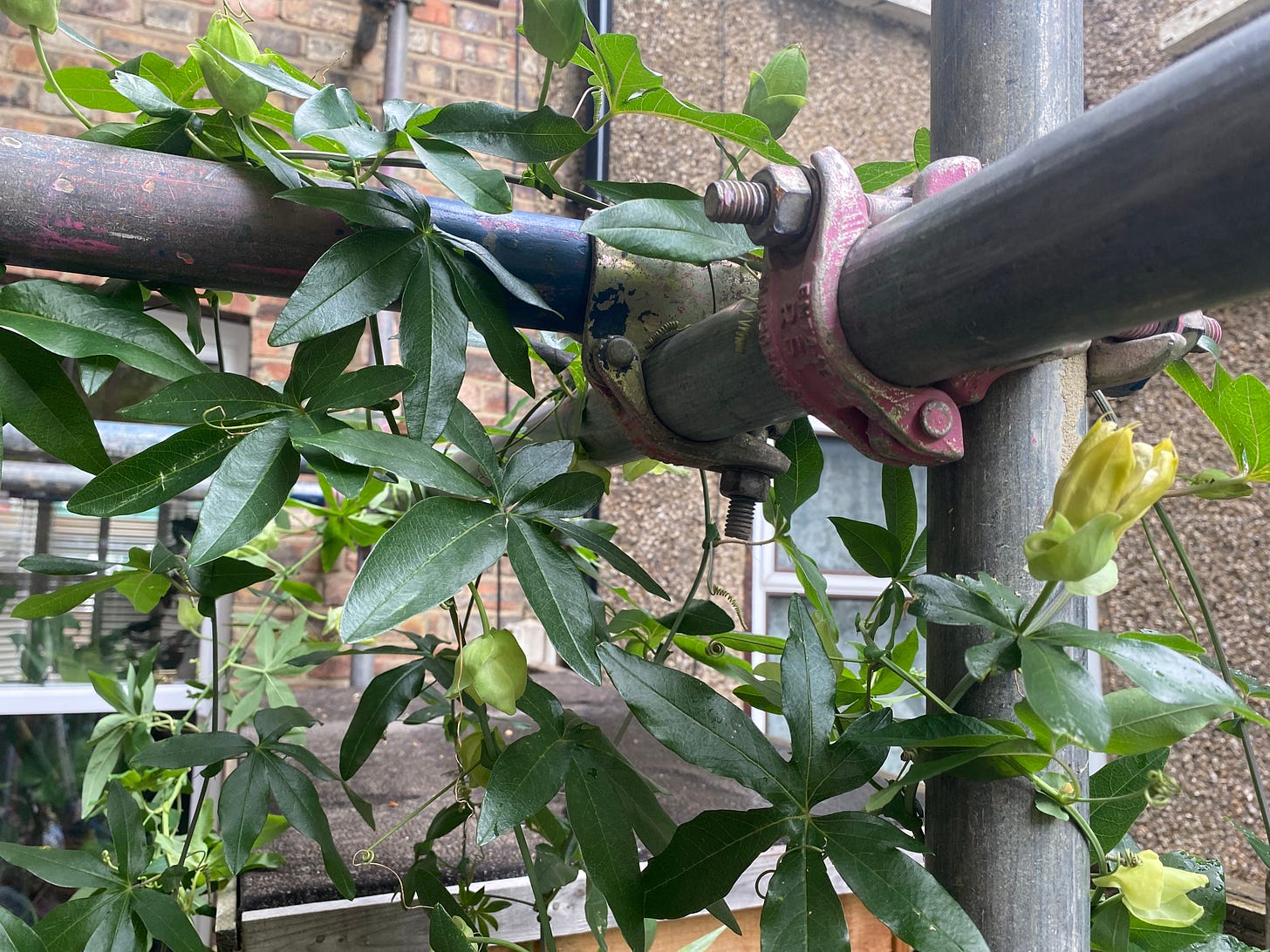Gardening with passion (flower)
An ode to one of the most neglected – and stunning – plants in my garden
Hello, you’re reading The Earthworm, an alternative gardening newsletter that takes a sideways look at the world of plants. The Earthworm is an independent, reader-supported newsletter, which means it’s thanks to people like you that The Earthworm can continue to exist. Thank you for reading.
I have done nothing to deserve the benevolence of my passion flower, nor its beauty. The plant first landed in my care a few years ago, a gift from a savvy family member. They knew that even a gardening novice like me, as I was at the time, would struggle to kill this hardy, hard-working vine. Needless to say, that didn’t stop me trying.
This blue passion flower, Passiflora caerulea, spent at least two years in its little nursery pot (from which it should have been released the day it came home), its stems still strapped to little chopstick-like stakes (as above). Its limbs were bound, its growth stunted. This was a plant destined for the compost heap.
Eventually, I grew so tired and guilty of this sad-looking little thing staring up at me from a dark corner of the patio, that I planted it behind a bushy shrub, where it would spend the next two years receiving no light and no love. Out of sight, out of mind.
Until last spring, that is, when I literally stumbled upon the by now forgotten passion flower while pruning one of its neighbours. The climber’s stems were weak and limp, its leaves tired and anaemic. But it was still alive. And so in what seemed even at the time to be an act of cruelty, I dug it up and moved it to the back of a shallow, overcrowded little bed, carved out of a corner of the patio – a section of garden with disastrous mortality statistics.
But yet again, against all the odds, the Passiflora survived. And more than that, it has since exploded into life, covering the fence against which it is trained with a thick netting of evergreen leaves.

It is only recently that I learned of the plant’s etymology, “passion” in this case not a reference to love or romance, but rather the Passion of Christ. Well, after the way that I have treated my Passiflora, and the way that it has forgiven my cruelty, I would say that its name is well-earned.
In my garden, I currently have nine climbing plants, which is pretty much one per fence panel. (And considering that most of these climbers can comfortably and quickly reach up to five metres in length, I objectively have too many of them in my small space.) Of these nine, the passion flower is easily now my favourite. It ticks every box.
Hardy down to -10ºC; equally at home in sunshine or part-shade; evergreen foliage keeping that fence covered all year round; and then there are the flowers. Oh my word, the flowers. The intricacy, the complexity, is jaw-dropping. Concentric circles of white, blue, purple and gold burst into bloom like little supernovas. Each flower lasts only a day, but they unfurl in turn, travelling down the clambering stems in a chain reaction of exquisite colour.
The flowers then turn into little fruits, which ripen to soft-skinned, apricot-like jewels, dangling from the vines. These are technically edible, though eating one is not a pleasant experience, unlike the more familiar, purple-peeled passion fruit from Passiflora edulis (literally “edible” in Latin). But come on, it would be plain greedy to ask this plant to produce delicious fruit, on top of everything else.
Our home is currently ensconced in a steel cage of scaffolding. The house is a darker, noisier, all together less pleasant place to spend time in at the moment. The garden is almost inaccessible, and certainly not easily navigable. And yet there is beauty to be found outside our kitchen window, where the passion flower has begun twining itself around the metal framework, treating it like a giant trellis.
The plant won’t thank me when I have to strip it from the scaffold beams in a few weeks’ time, of course. Then again, it has forgiven me for worse.
Three more excellent evergreen climbers
Like I said, my garden is full of climbing plants. Here are some of my favourites:





